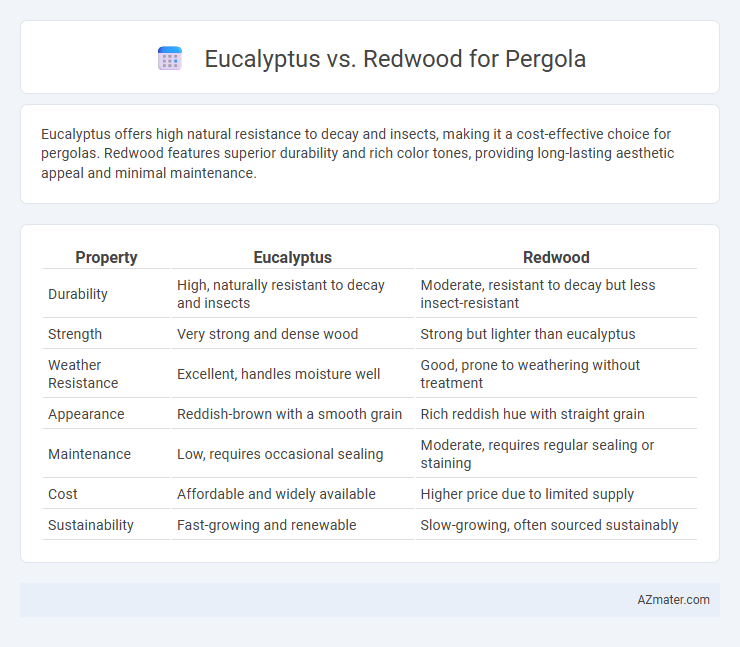Eucalyptus offers high natural resistance to decay and insects, making it a cost-effective choice for pergolas. Redwood features superior durability and rich color tones, providing long-lasting aesthetic appeal and minimal maintenance.
Table of Comparison
| Property | Eucalyptus | Redwood |
|---|---|---|
| Durability | High, naturally resistant to decay and insects | Moderate, resistant to decay but less insect-resistant |
| Strength | Very strong and dense wood | Strong but lighter than eucalyptus |
| Weather Resistance | Excellent, handles moisture well | Good, prone to weathering without treatment |
| Appearance | Reddish-brown with a smooth grain | Rich reddish hue with straight grain |
| Maintenance | Low, requires occasional sealing | Moderate, requires regular sealing or staining |
| Cost | Affordable and widely available | Higher price due to limited supply |
| Sustainability | Fast-growing and renewable | Slow-growing, often sourced sustainably |
Introduction to Eucalyptus and Redwood for Pergolas
Eucalyptus and Redwood are popular choices for pergola construction due to their durability and natural resistance to decay and insects. Eucalyptus offers a dense, hard wood with a rich color that ages gracefully while withstanding harsh weather conditions. Redwood is valued for its stability, lightweight nature, and striking reddish hue that enhances outdoor spaces while providing excellent structural integrity.
Key Characteristics of Eucalyptus Wood
Eucalyptus wood is highly valued for pergolas due to its exceptional durability, natural resistance to decay, and insect-repellent properties, making it suitable for outdoor use. Its dense grain and moderate hardness provide structural strength while maintaining a smooth finish that can be easily stained or painted to enhance weather resistance. Unlike Redwood, Eucalyptus tends to have a faster growth rate, offering a more sustainable option without compromising on stability and longevity in pergola construction.
Redwood: Features and Benefits for Outdoor Structures
Redwood offers superior resistance to decay and insects, making it an ideal choice for pergolas exposed to outdoor elements. Its natural oils provide durability and longevity, reducing maintenance compared to eucalyptus. Redwood's rich, reddish hue and fine grain enhance aesthetic appeal, creating a warm, inviting atmosphere for outdoor structures.
Durability Comparison: Eucalyptus vs Redwood
Eucalyptus offers high durability with natural oils that resist rot, insects, and decay, making it a cost-effective option for pergolas in diverse climates. Redwood is renowned for its superior decay resistance and natural tannins that provide long-lasting protection, especially in humid environments, though it often comes at a higher price point. Both woods are structurally strong, but redwood generally outperforms eucalyptus in longevity and resistance to environmental wear.
Resistance to Weather and Pests
Eucalyptus wood offers strong resistance to weather conditions due to its dense grain and natural oils that repel moisture and insects, making it a durable choice for pergolas in humid or rainy climates. Redwood is also highly resistant to decay and insects, thanks to its natural tannins, and performs well in various weather conditions, especially in dry or moderate climates. While both species provide excellent durability, eucalyptus tends to have a slight edge in repelling termites and fungal growth, whereas redwood is favored for its stability and ease of maintenance over time.
Aesthetic Appeal: Color, Grain, and Texture
Eucalyptus offers a rich reddish-brown hue that deepens over time, with a fine, interlocking grain and smooth texture, providing a modern, sleek look for pergolas. Redwood stands out with its warm, natural reddish-pink color, straight grain, and coarse texture that enhances a rustic, classic aesthetic. Both woods bring unique visual warmth and character, but eucalyptus tends to suit contemporary designs while redwood complements traditional outdoor structures.
Sustainability and Environmental Impact
Eucalyptus and redwood both offer sustainable options for pergola construction, with eucalyptus growing faster and requiring less water, which reduces environmental strain. Redwood naturally resists decay and insects without chemical treatments, contributing to longer-lasting structures and minimizing ecological impact. Choosing FSC-certified eucalyptus or redwood ensures responsible forestry practices that support biodiversity and carbon sequestration.
Maintenance Requirements and Longevity
Eucalyptus offers moderate durability and requires regular sealing and treatment to prevent decay and insect damage, making maintenance essential for longevity. Redwood exhibits natural resistance to decay and insects, reducing the need for frequent maintenance while ensuring a longer lifespan in outdoor structures like pergolas. Choosing redwood results in lower upkeep and enhanced durability, whereas eucalyptus demands consistent care to maintain structural integrity over time.
Cost Analysis: Eucalyptus vs Redwood Pergolas
Eucalyptus pergolas generally cost less than redwood due to the faster growth rate and widespread availability of eucalyptus trees, leading to lower raw material prices. Redwood, prized for its natural resistance to decay and rich reddish hue, commands a higher price reflecting its durability and aesthetic appeal. When budgeting, factor in eucalyptus's affordability and redwood's longer lifespan, balancing initial investment against maintenance and longevity for cost-effective pergola construction.
Conclusion: Choosing the Best Wood for Your Pergola
Eucalyptus offers superior durability and natural resistance to pests, making it an excellent choice for long-lasting pergolas, especially in humid or wet climates. Redwood provides exceptional aesthetic appeal with its rich color and natural resistance to decay, ideal for those prioritizing beauty and ease of maintenance. Choosing between eucalyptus and redwood depends on balancing the need for durability and weather resistance with visual preference and budget.

Infographic: Eucalyptus vs Redwood for Pergola
 azmater.com
azmater.com